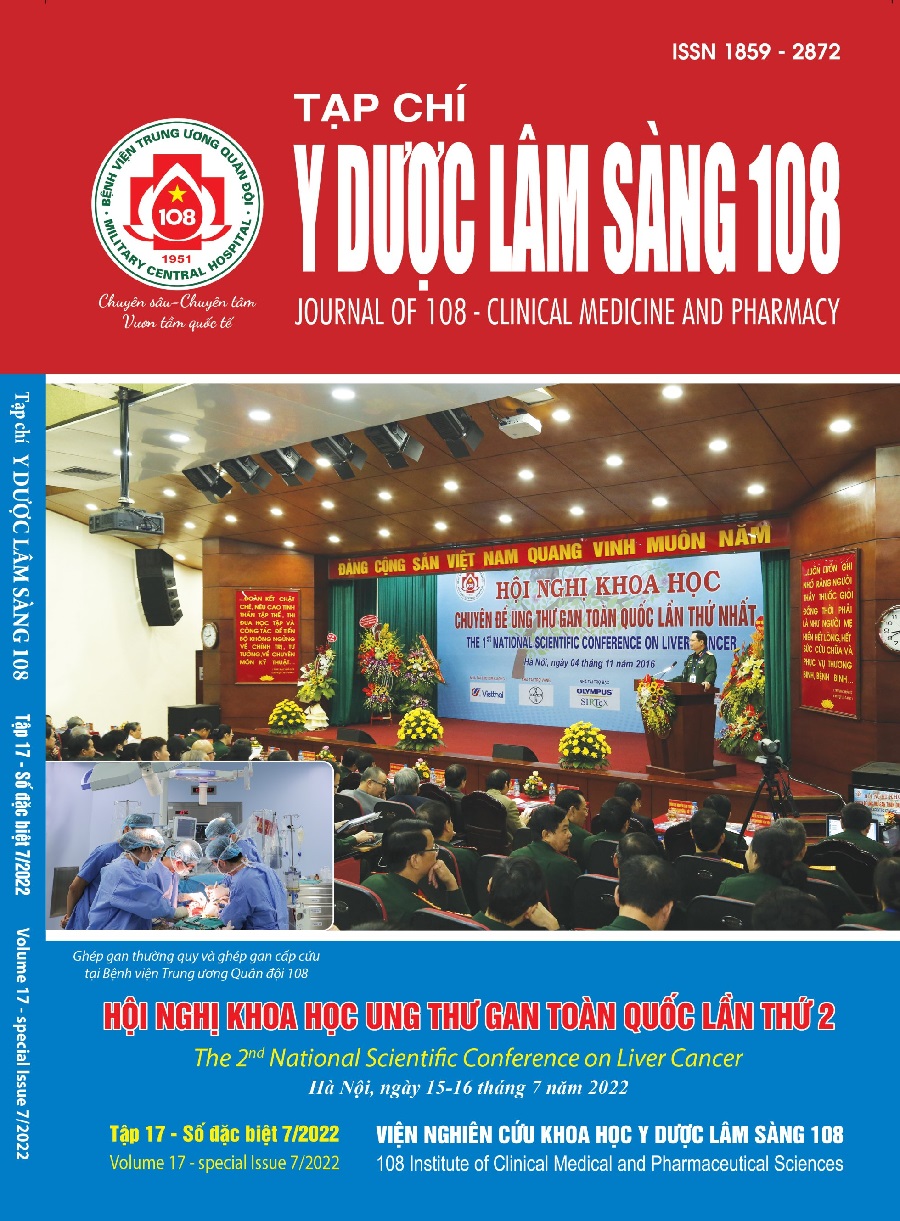Kết quả bước đầu xạ trị lập thể định vị thân ở bệnh nhân ung thư biểu mô tế bào gan có huyết khối tĩnh mạch cửa tại Bệnh viện Trung ương Quân đội 108
Main Article Content
Keywords
Tóm tắt
Mục tiêu: Đánh giá kết quả bước đầu và độc tính của kỹ thuật xạ trị lập thể định vị thân (SBRT) trong điều trị ung thư biểu mô tế bào gan giai đoạn tiến triển có huyết khối tĩnh mạch cửa (HKTMC). Đối tượng và phương pháp: Nghiên cứu tiến cứu, theo dõi dọc trên 30 bệnh nhân ung thư biểu mô tế bào gan có HKTMC, được điều trị bằng kỹ thuật SBRT, theo dõi từ tháng 07/2018 đến tháng 04/2021. Đánh giá tỷ lệ đáp ứng huyết khối, trung vị thời gian sống thêm, thời gian sống thêm toàn bộ (OS), và các tác dụng phụ. Kết quả: Vị trí huyết khối chủ yếu là Vp3 + Vp4 chiếm 53,3%. Liều xạ trung bình: 35,7 ± 3,1Gy/3 - 5 phân liều. Tỷ lệ đáp ứng huyết khối sau 1 tháng, 3 tháng lần lượt là 80%, 73,3%. Trung vị thời gian sống thêm toàn bộ 14,5 tháng, tỷ lệ sống thêm toàn bộ sau 6 tháng, 1 năm lần lượt là 96,7%, 63,3%. Các độc tính chủ yếu độ 1 - 2 gồm mệt mỏi, buồn nôn, đau hạ sườn phải. Kết luận: SBRT là phương pháp có hiệu quả và an toàn trong điều trị ung thư biểu mô tế bào gan có HKTMC với độc tính thấp.
Article Details
Các tài liệu tham khảo
2. Minagawa M, Makuuchi M (2006) Treatment of hepatocellular carcinoma accompanied by portal vein tumor thrombus. World J Gastroenterol 47: 7561-7567.
3. Llovet JM, Bustamante J, Castells A et al (1999) Natural history of untreated nonsurgical hepatocellular carcinoma: rationale for the design and evaluation of therapeutic trials. Hepatology, 29(1): 62-67.
4. Cheng AL, Guan Z, Chen Z, et al (2012) Efficacy and safety of sorafenib in patients with advanced hepatocellular carcinoma according to baseline status: Subset analyses of the phase III Sorafenib Asia-Pacific trial. European Journal of Cancer 48(10): 1452-1465.
5. Kudo M, Finn RS, Qin S et al (2018) Lenvatinib versus sorafenib in first-line treatment of patients with unresectable hepatocellular carcinoma: A randomised Phase 3 non-inferiority trial. Lancet 391(10126): 1163-1173.
6. NCCN Clinical Practice Guidelines in Oncology: Hepatobiliary Cancers version 5.2020.
7. Korean Liver Cancer Study Group (KLCSG); National Cancer Center, Korea (NCC) (2015) 2014 Korean Liver Cancer Study Group-National Cancer Center Korea practice guideline for the management of hepatocellular carcinoma. Korean J Radiol 16: 465-522.
8. Bộ Y tế (2020) Quyết định số 3129/QĐ-BYT về việc ban hành tài liệu chuyên môn Hướng dẫn chẩn đoán và điều trị ung thư biểu mô tế bào gan.
9. Tublin ME, Dodd GD, Richard LB (1997) Benign and malignant portal vein thrombosis: Differentiation by CT characteristics. AJR: 168.
10. Llovet JM, Bru C, Bruix J (1999) Prognosis of hepatocellular carcinoma: The BCLC staging classification. Semin Liver Dis 19(3): 329-338.
11. Llovet JM, Di Bisceglie AM, Bruix J, Kramer BS et al (2008) Design and endpoints of clinical trials in hepatocellular carcinoma. J Natl Cancer, Inst 100: 698-711.
12. Choi HS, Kang KM, Jeong BK et al (2020) Effectiveness of stereotactic body radiotherapy for portal vein tumor thrombosis in patients with hepatocellular carcinoma and underlying chronic liver disease. Asia Pac J Clin Oncol 17(3): 209-215. https://doi.org/ 10.1111/ ajco.13361.
13. Shui Y, Yu W, Ren X et al (2018) Stereotactic body radiotherapy based treatment for hepatocellular carcinoma with extensive portal vein tumor thrombosis. Radiation Oncology 13: 188.
14. Jeong BK (2018) Stereotactic-body radiotherapy for portal vein tumor thrombosis in hepatocellular carcinoma patients. Journal of Clinical Oncology 36(4): 442-442.
15. Que J, Wu HC, Lin CH et al (2020) Comparison of stereotactic body radiation therapy with and without sorafenib as treatment for hepatocellular carcinoma with portal vein tumor thrombosis. Medicine 99: 13. DOI: 10.1097/MD. 0000000000019660.
 ISSN: 1859 - 2872
ISSN: 1859 - 2872
